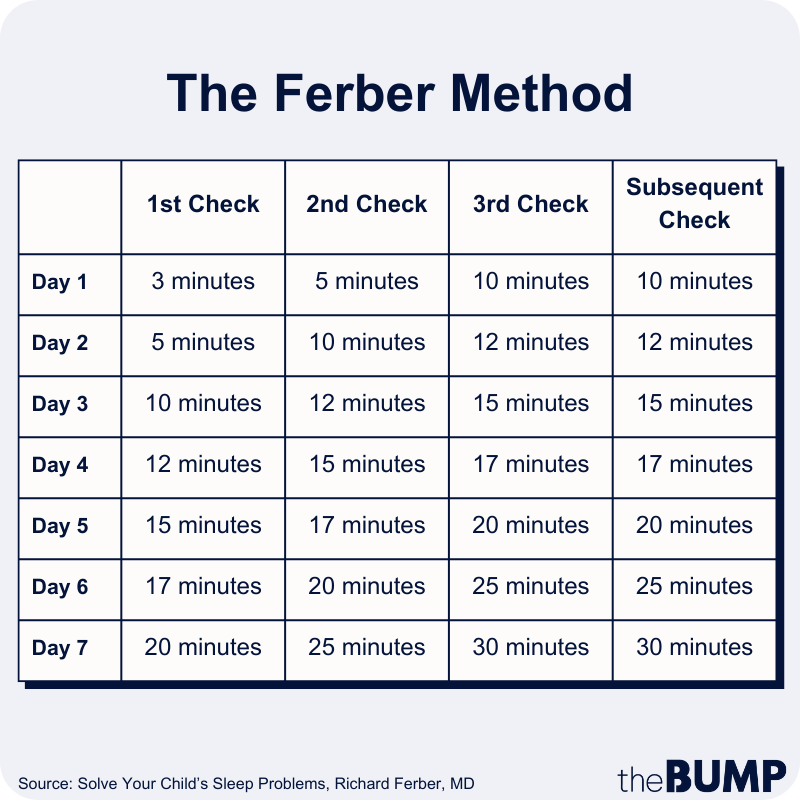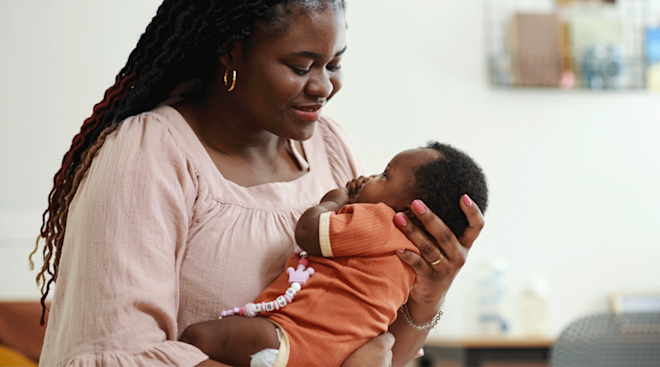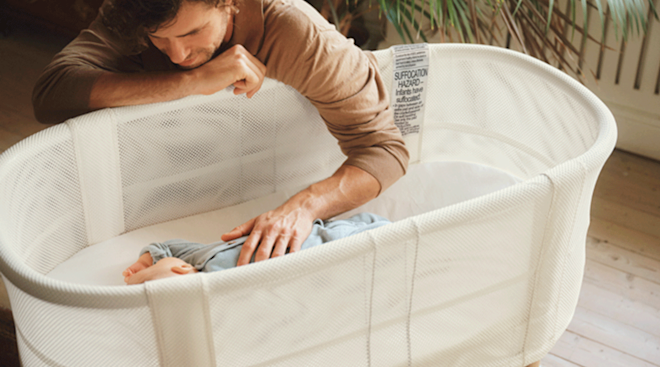Is the Ferber Method of Sleep Training Right for Your Family?
When you have a baby, sleep as you once knew it goes out the door. While most parents are okay with this truth for a while, there comes a point when getting a good night of rest feels like a pipe dream. Unfortunately, many babies are perfectly content waking themselves (and you) up at the oddest of hours, and they’re likely to keep up with these middle-of-the night check-ins until they’re taught otherwise. This is precisely why many parents turn to the Ferber method—a form of sleep training that encourages babies to snooze through the night. You’ve probably heard of the Ferber sleep method at some point but might be hazy on the details, including why some caregivers consider it sort of controversial. Ready to get the 411 on the Ferberizing Technique? Here, pediatric sleep consultants and pediatricians break it all down, so you can get informed and—hopefully—get more zzz’s.
The Ferber method is a “cry-it-out” method of sleep training, based on the 1985 best-selling book Solve Your Child’s Sleep Problems by Richard Ferber, MD. In the book, Ferber discusses the role of sleep associations–or the things baby correlates with bedtime. “The conditions that help a baby fall asleep at night are the same conditions required to put baby back to sleep after night wakings,” says Whitney Schutzbank, MD, MPH, a pediatrician at the MassGeneral Hospital for Children in Boston. Ferber encourages parents to remove those conditions—which baby learns to associate with sleep, like feeding or rocking—so that babies will learn to put themselves to bed without their parents’ help. While often discussed in regards to overnight sleep, it’s important to note that the Ferber method is used with all baby sleep, including naps, adds Rachel Mitchell, a certified pediatric sleep consultant and founder of My Sweet Sleeper. “Because day and night sleep go hand in hand, following a similar approach with both naps and nights can be helpful.”
Of course, babies would rather have your help falling asleep, so they’ll often cry at naptime, bedtime or in the middle of the night while learning to put themselves to bed. “According to Ferber, the fastest and most efficient way to teach your children to sleep through the night is to let them cry at these times,” Schutzbank says.
Sleep training (whether it’s the Ferber method or any type) is not recommended for babies until they’re 4 to 6 months old, says Jeffrey Bourne, MD, a pediatrician at Providence Saint John’s Health Center in Santa Monica, California. Before that point, baby may still need to eat in the middle of the night.
While you don’t want to start too early, you also shouldn’t wait too long: It’s also best to sleep-train before baby is one year old. “After a year, they have a whole bunch of habits and patterns set, and it can be harder to break them,” Bourne says. Regardless of age, always talk to your pediatrician before starting a sleep-training program. This way, you can be sure baby is growing well and is ready to be done with overnight feedings.
The Ferber method of sleep training lays out a very specific, progressive regimen for getting baby to sleep at night. If baby has been sleeping in your room until this point (which is advised by the American Academy of Pediatrics (AAP) for at least the first six months), it’s best to move them into their own room in a crib to start Ferber training. Below, some expert tips to help you get started:
- Put baby to sleep in their room drowsy, but awake. It should be dark and quiet, Schutzbank says.
- If baby cries, check in at regular but increasingly longer intervals. Generally, Ferber sleep training recommends checking on baby after certain increments. With each day, gradually extend the amount of time between check-ins. This process is known as “gradual extinction.”
During these check-ins, you can reassure baby by patting them gently, but don’t pick them up or feed them. Then, leave the room before they fall asleep. Soon enough, baby should get the hang of it. “Usually after about five to seven days, the interval of time spent crying is much shorter, and your child will be putting themselves to sleep and sleeping for much longer periods of time at night,” Schutzbank says.
Below, we’ve outlined the check-in increments for the first seven days:
Day 1
As you begin introducing baby to the Ferber sleep method, you’ll check in more frequently with them during the first few nights. While it may be difficult at first, try your best to stick to these check-in times for the best results.
- First check-in: 3 minutes after baby starts crying
- Second check-in: 5 minutes
- Third check-in: 10 minutes
- Subsequent check-ins: 10 minutes
Day 2
Congratulations, you made it through the first night! As baby gets accustomed to this new routine, you’ll gradually begin extending the amount of time you allow baby to cry before checking on them.
- First check-in: 5 minutes after baby starts crying
- Second check-in: 10 minutes
- Third check-in: 12 minutes
- Subsequent check-ins: 12 minutes
Day 3
Continue spreading out your check-in times, extending your first check-in from 5 to 10 minutes on day three.
- First check-in: 10 minutes after baby starts crying
- Second check-in: 12 minutes
- Third check-in: 15 minutes
- Subsequent check-ins: 15 minutes
Day 4
You’re over halfway through your first week of Ferber sleep training, and you’re doing great. You can now check in on baby at up to 17-minute intervals.
- First check-in: 12 minutes after baby starts crying
- Second check-in: 15 minutes
- Third check-in: 17 minutes
- Subsequent check-ins: 17 minutes
Day 5
By day five, you can push your first check-in to 15 minutes, and wait a full 20 minutes between subsequent check-ins if baby continues to fuss.
- First check-in: 15 minutes after baby starts crying
- Second check-in: 17 minutes
- Third check-in: 20 minutes
- Subsequent check-ins: 20 minutes
Day 6
At the six-day mark, you can extend your subsequent check-ins to 25-minute intervals.
- First check-in: 17 minutes after baby starts crying
- Second check-in: 20 minutes
- Third check-in: 25 minutes
- Subsequent check-ins: 25 minutes
Day 7
By day 7, you and baby should notice some major progress.
- First check-in: 20 minutes after baby starts crying
- Second check-in: 25 minutes
- Third check-in: 30 minutes
- Subsequent check-ins: 30 minutes
Keep in mind, these are just suggested time frames. As Bourne points out, Ferber sleep training can be personalized if you feel the precise time-frame recommendations aren’t right for your family (more on this below). Just be aware that changing things up—particularly checking on baby more frequently—may prolong the process.
Ferber method chart
The good news is that this sleep training method can be very effective. According to Mitchell, with the Ferber Method, you may see some progress in three to five nights. That said, it generally takes up to two weeks.
The Ferber sleep method can feel tedious and stressful (no one likes to hear baby cry!). These expert tips can make it a bit easier on you and baby:
- Build a bedtime routine. The benefits of a baby bedtime routine have long been proven. Babies love consistency, so begin a bedtime routine around the time baby is 6 to 8 weeks old. At the same time each evening, start the process of getting baby reading for bed—that might include giving them a bath, reading them a story and getting them calm and relaxed.
- Put baby to bed drowsy but awake. For the Ferber method to work, you want to ensure baby is still awake when you put them to bed. This helps them learn to fall asleep on their own. If baby is already sleeping when you put them down, they won’t notice the difference.
- Avoid simultaneous changes. As mentioned, babies do best when they follow a consistent routine, so trying to sleep train baby while they’re dealing with other changes may not go over well. For example, if baby is teething or getting used to a new environment, it may be more difficult for them to also adjust to the Ferber sleep method. Keep changes to baby’s routine limited to one at a time as much as possible.
- Remain committed and consistent. One of the tips experienced parents offer for Ferber sleep training? Stay firm in your course and trust the process. “As long as you’re committed to staying the course, it’s wonderful and works amazingly well,” says Laura, a mom of two. “If you’re going to be wishy-washy, then I’d highly discourage this method. You have to be firm in your decision.”
- Don’t look at your timer for the check-ins. Kathy S., a mom of two, used the Ferber sleep method with her twins. Her biggest tip? Set a timer for your “away times,” but avoid staring at it. Instead, she suggests finding something to keep yourself busy, such as a puzzle, a crochet pattern or even fidget toys. “They helped ease the anxiety and guilt I felt about ‘leaving my baby to cry’ during those time periods,” she says. As hard as it can be, she emphasizes that it does get better. “The first night we tried this method, it took my daughter 45 minutes to finally go to sleep, but the second night it took 10 minutes!”
The biggest controversy with the Ferber sleep method is the need to let baby cry it out in order to teach them how to fall asleep by themselves. Critics of Ferber sleep training say that letting baby cry without comforting them could be emotionally traumatic, but there’s no science to prove this claim. “There have been no studies that show negative long-term outcomes for babies who underwent sleep training with the Ferber method versus those who didn’t,” Schutzbank says. “This method can be extremely helpful for overtired parents and children to allow everyone to get the sleep they need.”
Bourne agrees. “Crying itself doesn’t hurt babies,” he says. In fact, a 2016 Pediatrics paper demonstrated that there’s no significant difference in stress levels in infants being sleep trained with gradual extinction (as measured by stress hormone levels in their saliva) compared to a control group. Better yet, those babies were eventually able to fall asleep 13 minutes earlier than the non-sleep-trained babies, and woke up significantly less often.
While the Ferber method isn’t harmful for babies, it’s not for everyone—and that’s okay. Mitchell encourages parents to “be in tune with their baby and respond as they feel comfortable.” Luckily, there are plenty of gentle sleep training approaches you can try. For starters, you might try a modified Ferber method by switching up the length of the timed intervals and shortening them by a couple of minutes. Or, instead of following the timed intervals, you might follow baby’s cues. “For example, if they’re supposed to wait 20 minutes before going in, but baby has become hysterical or is crying hard, parents may go in right away and soothe baby without picking them up if they’re trying to promote a bit more independence,” Mitchell says.
If skipping over the Ferber method entirely is the right call for your family, know there are other techniques for sleep training to try. Some of these include:
- The chair method: The chair method involves sitting next to baby’s crib in a chair and moving it further away each night. If baby starts to fuss, the goal is to use calming words and shushing sounds to soothe them as much as possible.
- Pick up and put down method: The method is like the Ferber method, in that you check in on baby in intervals, but it allows you to pick up baby and soothe them before putting them back in their crib, Mitchell says.
- The five-step method: In this method of sleep training, parents follow a few simple steps, Mitchell notes. The first is assessing whether baby is actually awake or lightly fussing in their sleep. The second is trying to soothe them without picking them up. The third is picking them up, rocking or nursing them to sleep if they’re still fussy. The fourth is setting your calmed or sleeping baby back in their crib and leaving the room. You can repeat these steps as needed until baby stays asleep. “With this approach you’re really taking into consideration how your child is responding, rather than a specific set of time and intervals,” Mitchell explains. “I find this allows parents to feel much more in tune with their baby, and it’s less stressful for all.”
When to stop trying the Ferber method
Ultimately, the goal behind any sleep training method is a good night’s sleep for the whole family. That said, if listening to baby’s cries is doing you more harm than good, it’s time to stop the Ferber method and try a different approach. “I know many parents do find success with the Ferber method, but I do recommend that parents stop trying it if it’s clearly distressing,” Mitchell says. “The Ferber method is not for every child and some children simply won’t take to it.” If you’re not seeing the progress you’re hoping for or noticing baby’s sleep is actually getting worse, it’s time to move on to a different method of sleeping training.
“What I remind all parents is that the first step when approaching your baby’s sleep is to address the underlying cause of their child’s sleep issues,” Mitchell says. Her advice? Look at baby’s sleep environment, bedtime routine, wake windows, diet and activity to see if there’s anything that can help improve baby’s overall sleep. “While [your] response does play a role in baby’s sleep, starting with the core foundations and then applying a gentle approach is often very effective,” she adds.
Ultimately, how you decide to sleep train baby is entirely up to you. If you’d like to try Ferber sleep training, get the okay from your child’s pediatrician and make plans to get started. The Ferber method works best when everyone in the family is willing and prepared to have a few nights with less sleep, like over the weekend, Schutzbank says.
As with anything new you introduce, the Ferber sleep method may take some time and practice. Have patience and faith in the process. But remember, at the end of the day, you know baby best—if this method doesn’t feel right to you, it’s fine to move on. Either way, know that sleep will be in your very near future.
Please note: The Bump and the materials and information it contains are not intended to, and do not constitute, medical or other health advice or diagnosis and should not be used as such. You should always consult with a qualified physician or health professional about your specific circumstances.
Plus, more from The Bump:
Jeffrey Bourne, MD, is a pediatrician at Providence Saint John’s Health Center in Santa Monica, California. He received his medical degree from the University of Washington and has been practicing for over 20 years. He completed his residency at the University of Hawaii.
Rachel Mitchell is a Boston-based certified maternity and pediatric sleep consultant, former night nanny and mom to seven. She’s the founder of My Sweet Sleeper, a team of maternity and pediatric sleep specialists that help growing families get some much needed shut-eye, as well as the founder of Sweet Sleep Academy, a pediatric sleep consultant certification program.
Whitney Schutzbank, MD, MPH, is a pediatrician at the MassGeneral Hospital for Children in Boston. She earned her medical degree from Tulane University School of Medicine, specializing in newborn medicine. She completed her residency at Massachusetts General Hospital.
American Academy of Pediatrics, Safe Sleep, August 2023
Sleep Medicine Reviews, Benefits of a bedtime routine in young children: Sleep, development, and beyond, November 2017
Healthy Children (American Academy of Pediatrics), Getting Your Baby to Sleep, August 2022
Pediatrics (American Academy of Pediatrics), Behavioral Interventions for Infant Sleep Problems: A Randomized Controlled Trial, June 2016
Learn how we ensure the accuracy of our content through our editorial and medical review process.
Navigate forward to interact with the calendar and select a date. Press the question mark key to get the keyboard shortcuts for changing dates.









































![Tan France, celebrity personality from the popular TV shoe]w Queer Eye.](https://images.ctfassets.net/6m9bd13t776q/2uqRZn7bkb4nWv28drOW16/98b7493289f8f84d699ffa7516be8f90/tan-france-baby-sleep-products-660x367.jpg?q=75&w=660)











